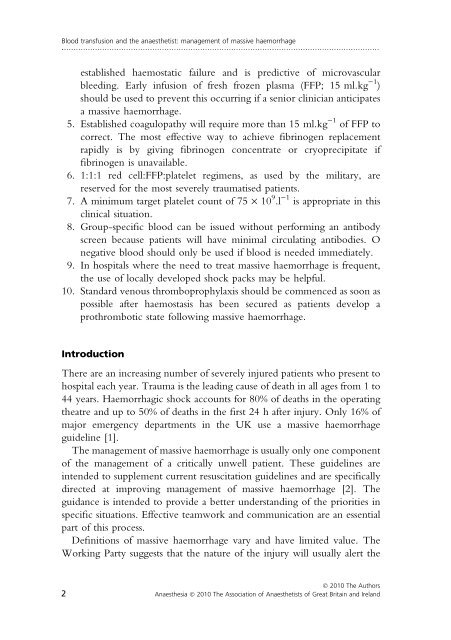Blood transfusion and the anaesthetist: management of ... - aagbi
Blood transfusion and the anaesthetist: management of ... - aagbi
Blood transfusion and the anaesthetist: management of ... - aagbi
You also want an ePaper? Increase the reach of your titles
YUMPU automatically turns print PDFs into web optimized ePapers that Google loves.
<strong>Blood</strong> <strong>transfusion</strong> <strong>and</strong> <strong>the</strong> anaes<strong>the</strong>tist: <strong>management</strong> <strong>of</strong> massive haemorrhage<br />
.....................................................................................................................................<br />
established haemostatic failure <strong>and</strong> is predictive <strong>of</strong> microvascular<br />
bleeding. Early infusion <strong>of</strong> fresh frozen plasma (FFP; 15 ml.kg )1 )<br />
should be used to prevent this occurring if a senior clinician anticipates<br />
a massive haemorrhage.<br />
5. Established coagulopathy will require more than 15 ml.kg )1 <strong>of</strong> FFP to<br />
correct. The most effective way to achieve fibrinogen replacement<br />
rapidly is by giving fibrinogen concentrate or cryoprecipitate if<br />
fibrinogen is unavailable.<br />
6. 1:1:1 red cell:FFP:platelet regimens, as used by <strong>the</strong> military, are<br />
reserved for <strong>the</strong> most severely traumatised patients.<br />
7. A minimum target platelet count <strong>of</strong> 75 · 10 9 .l )1 is appropriate in this<br />
clinical situation.<br />
8. Group-specific blood can be issued without performing an antibody<br />
screen because patients will have minimal circulating antibodies. O<br />
negative blood should only be used if blood is needed immediately.<br />
9. In hospitals where <strong>the</strong> need to treat massive haemorrhage is frequent,<br />
<strong>the</strong> use <strong>of</strong> locally developed shock packs may be helpful.<br />
10. St<strong>and</strong>ard venous thromboprophylaxis should be commenced as soon as<br />
possible after haemostasis has been secured as patients develop a<br />
prothrombotic state following massive haemorrhage.<br />
Introduction<br />
There are an increasing number <strong>of</strong> severely injured patients who present to<br />
hospital each year. Trauma is <strong>the</strong> leading cause <strong>of</strong> death in all ages from 1 to<br />
44 years. Haemorrhagic shock accounts for 80% <strong>of</strong> deaths in <strong>the</strong> operating<br />
<strong>the</strong>atre <strong>and</strong> up to 50% <strong>of</strong> deaths in <strong>the</strong> first 24 h after injury. Only 16% <strong>of</strong><br />
major emergency departments in <strong>the</strong> UK use a massive haemorrhage<br />
guideline [1].<br />
The <strong>management</strong> <strong>of</strong> massive haemorrhage is usually only one component<br />
<strong>of</strong> <strong>the</strong> <strong>management</strong> <strong>of</strong> a critically unwell patient. These guidelines are<br />
intended to supplement current resuscitation guidelines <strong>and</strong> are specifically<br />
directed at improving <strong>management</strong> <strong>of</strong> massive haemorrhage [2]. The<br />
guidance is intended to provide a better underst<strong>and</strong>ing <strong>of</strong> <strong>the</strong> priorities in<br />
specific situations. Effective teamwork <strong>and</strong> communication are an essential<br />
part <strong>of</strong> this process.<br />
Definitions <strong>of</strong> massive haemorrhage vary <strong>and</strong> have limited value. The<br />
Working Party suggests that <strong>the</strong> nature <strong>of</strong> <strong>the</strong> injury will usually alert <strong>the</strong><br />
Ó 2010 The Authors<br />
2 Anaes<strong>the</strong>sia Ó 2010 The Association <strong>of</strong> Anaes<strong>the</strong>tists <strong>of</strong> Great Britain <strong>and</strong> Irel<strong>and</strong>

















